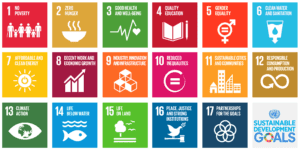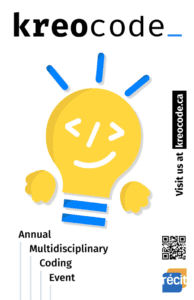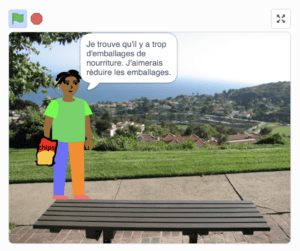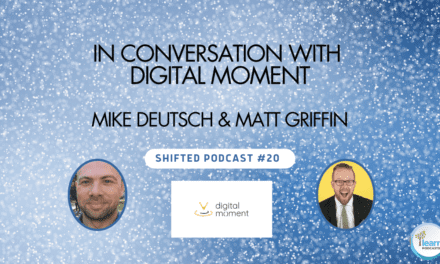“There must be a better way to make the things we want, a way that doesn’t spoil the sky, or the rain or the land.” – Paul McCartney
We only have one Earth and it is being depleted at an alarming rate. It’s no surprise that as a collective, we must aim for more sustainable practices that will not compromise the ability of future generations to meet their own needs (Brundtland, 1987). In 2015, the United Nations (UN) came together and agreed on an ambitious agenda, or as they call it, “a blueprint to achieve a better and more sustainable future for all.” They adopted the 17 Sustainable Development Goals (SDGs), also known as the Global Goals.
The SDGs are interlinked and designed to promote sustainable development in three dimensions: economic growth, social inclusion and environmental protection. These dimensions are often referred to as the “three pillars of sustainability” (United Nations).
The 17 goals are meant to address the world’s most pressing issues such as:
ending poverty, providing equal access to quality education and healthcare, addressing climate change, lowering consumption waste, and many more.
Each goal represents a target for every country to implement by 2030.

In Peter Drucker’s view, “The best way to predict the future is to create it.” As educators, our global mission is to teach the curriculum, but also to enhance our students’ knowledge of the world they live in and equip them with skills to make their own positive changes to it. After all, the future belongs to our students – why not include them in the challenges of creating a better future for all?
As you’ll see in this blog post, the children, as young as kindergarten, who participated in a SDG-related challenge were capable and proud of presenting and applying solutions to a real-life, global issue. In their case, they came up with ideas to decrease waste production.
Every student or person on Earth should have access to clean water, affordable renewable energy, healthy food, quality education, and a safe place to live. Introducing these topics of global importance is a great way to engage students and work together toward a better future.
What Does This Look Like in a Classroom?
Incorporating the SDGs into your classroom practice can be done very naturally. The 17 goals are well aligned to the cross-curricular competencies and there are so many ways of addressing sustainability in all subject areas.
Some ideas include:
–Languages: practice vocabulary, create awareness campaigns or posters, make videos or media, etc.
–Math, Science & Technology: collect, analyze and use data, use technology to prototype solutions, etc.
–STEAM education: Use the design process to develop and prototype solutions or to create awareness.
–Ethics: implement discussion boards, create campaigns for awareness of the poverty line, world hunger, global food chain, quality education, etc., and discuss gender equality in the workforce.
–Social Sciences: study diverse places, cities, resources and natural & human environments, examine poverty in parts of the world over time (making timelines) or the history of food consumption in different countries and cultures, research the climate action of nature (animal extinctions, fisheries, etc.), study the history for peace, justice and institutions (comparing justice systems and the racial biases in countries).
–Physical Education: promote healthy habits & physical activity, discuss zero hunger (the effects of food and diet on the body), clean water and sanitation (the importance of hydration and good hygiene habits, responsible consumption (the fitness industry and the responsibility to reduce clothing consumption) or sustainable cities and fitness.
–Art and music: Connect and create musical pieces or art based on things found from the earth, sustainable art, art from recycled materials
Examples of Projects
Over the past years, the LEARN team has been supporting teachers and students with the integration of the SDGs throughout different projects.
Here are two examples of projects that Quebec students have participated in: do your :bit and Kreocode.
Both projects challenge students to present or prototype solutions to a specific global goal.
The Micro:bit “do your :bit” Challenge

The Micro:bit “do your :bit” Challenge
The Micro:bit “do your :bit” Challenge is a competition organized by the Micro:bit Educational Foundation, in partnership with the United Nations Development Programme (UNDP) and the World’s Largest Lesson. The challenge invites young people worldwide to develop innovative solutions to real-world sustainability challenges, using the Micro:bit, a small programmable computer.
The Micro:bit “do your :bit” challenge is a great way to engage young people in sustainability issues and promote the use of technology for social good. By encouraging young people to think creatively and develop practical solutions, the challenge helps to inspire the next generation of innovators and problem-solvers who will help to create a more sustainable world. It also emphasizes the idea that everyone has a role to play in promoting sustainability and that small actions can have a big impact. Actions can, for example, include reducing energy consumption, using public transport, recycling, reducing waste, and choosing sustainable products.
One student we worked with was concerned about the level of waste being generated from her household and wished to reduce the amount of waste produced by her family. After extensive research and lots of creativity, she prototyped and coded a system with the Micro:bit that could be attached to the kitchen garbage can. The Micro:bit would count the number of times the garbage can was opened and would measure the level of garbage being accumulated. Her awareness around waste production and management also led her family to become more conscious about what they purchased and how it was packaged.
View examples of student productions here.
Kreocode Coding Event

Kreocode Poster
The Kreocode event was created by a group of RÉCIT consultants with the aim of offering a provincial coding event for all levels (preschool, youth sector and adult general education) and all subject areas. Students were asked to use block programming (Scratch or ScratchJr) to illustrate a solution to a real-life global challenge. To inspire students, the Kreocode committee decided to use one of the United Nations Sustainable Development Goals (SDGs) as a prompt. Using Scratch or ScratchJr, students were invited to present solutions to Sustainable Development Goal no. 12, which is to establish sustainable consumption and production patterns.
Teachers who were interviewed mentioned they started off by discussing sustainability with their students. This step also included watching videos about the SDGs, as well as existing Scratch productions. Over the course of several periods, the students researched and brainstormed ideas as well as solutions. Several groups used storyboards to plan out their presentation. Once their text or storyboard was ready, the students explored and played with the different options in Scratch, such as characters (or sprites), backdrops, costumes, dialogue, audio recording, scenes, etc. The final Scratch products included interactive stories and games.
 One inspiring project was from a student who wanted to create awareness about food packaging. In their interactive Scratch story, they animated a boy leaving a bag of chips on a park bench, which made the Earth very sad. The boy then went to a “en vrac” store, where they talked with the store manager and refilled their bag of chips rather than buying a new bag. Click here to view the student’s Scratch project. Other inspiring projects from the Kreocode coding event can be viewed here.
One inspiring project was from a student who wanted to create awareness about food packaging. In their interactive Scratch story, they animated a boy leaving a bag of chips on a park bench, which made the Earth very sad. The boy then went to a “en vrac” store, where they talked with the store manager and refilled their bag of chips rather than buying a new bag. Click here to view the student’s Scratch project. Other inspiring projects from the Kreocode coding event can be viewed here.
Many documents and guides were created in link with the SDGs and Scratch/ScratchJr. Videos and online resources were also curated. These supporting resources can be found on Kreocode.ca. Most of the projects were placed in Scratch studios so they could be shared publicly. Some projects unfortunately couldn’t be published because of copyright issues such as images being used with attribution (a good conversation to have with students).
When Incorporating the SDGs in Education, Keep in Mind That..
- Many resources already exist.
The first step in using the SDGs in education is to introduce them to students. Educators can use a range of resources, such as videos, posters, and interactive activities to explain the goals and their relevance to students’ lives. This can help students understand the importance of sustainable development and motivate them to take action. There are tons of resources on the Internet, just like for the do your:bit and Kreocode challenges.
Here are a few more:
Video: What is sustainable development?
Video: The World’s Largest Lesson
The World’s Largest Lesson Resources: Search their bank of resources using filters
LEARN’s Wakelet of curated resources for Goal no12 (in link with the Kreocode Challenge).
LEARN Padlet: The Micro:bit/Sustainable development goals challenges
LEARN SDG Book Padlet: A list of recommended books
- SDGs easily align with curriculum and cross-curricular competencies.
Once students are familiar with the SDGs, educators can align their curriculum with the goals. This can be done by incorporating SDGs into lesson plans and projects, such as designing a sustainable community, exploring renewable energy sources, or analyzing the impact of climate change on different regions. By integrating the SDGs into the curriculum, educators can provide students with a holistic understanding of sustainable development and prepare them to be global citizens, all while developing their cross-curricular competencies.
- Using SDGs in education fosters critical thinking and problem-solving skills.
The SDGs require innovative solutions to complex global challenges. To prepare students for this, educators can foster critical thinking and problem-solving skills by encouraging students to think creatively and develop solutions to real-world problems. This can be achieved through activities such as case studies, debates, and simulations, which challenge students to analyze problems from different perspectives and develop practical solutions.
- …and encourages action and community engagement.
The SDGs are not just a theoretical framework; they require action and community engagement to achieve. Educators can encourage students to take action by organizing community service projects, participating in local sustainability initiatives, or developing awareness campaigns. These activities can help students develop leadership and teamwork skills, while also making a positive impact on their communities.
“Do not wait for extraordinary circumstances to do good action; try to use ordinary situations”
—Jean Paul Richter
The Sustainable Development Goals provide a powerful framework for creating engaging and impactful learning experiences for students. Introducing the goals in the classroom aligns with the curriculum, fosters critical thinking and problem-solving skills, and encourages action and community engagement. And more importantly, it prepares students to be active and engaged global citizens who are equipped to tackle the world’s most pressing challenges.
If you are interested in trying the “do your :bit” or Kreocode challenges, my biggest suggestion would be to Go For It! Support is available if you need it – don’t hesitate to reach out to your local RÉCIT consultant or the LEARN pedagogical consultants for support or questions. Here is the Directory of Consultants.
Resources
Brundtland, G.H. (1987). Our Common Future: Report of the World Commission on Environment and Development. Geneva, UN-Dokument A/42/427. www.un-documents.net/ocf-ov.htm
Cohen, W. A. (2010). Drucker on Leadership: New Lessons From the Father of Modern Management. San Francisco, CA: Jossey-Bass
United Nations, www.un.org/sustainabledevelopment/sustainable-development-goals/
Picture Credits
Image of hand holding globe: Shutterstock license 1790497901
Poster of the 17 SDGs
do your :bit logo by the BBC Micro:bit site
Kreocode Poster
Kreocode Scratch Project





